Lipid Peroxidation Assay: Liver Homogenate and Antioxidant Effects
VerifiedAdded on 2023/04/21
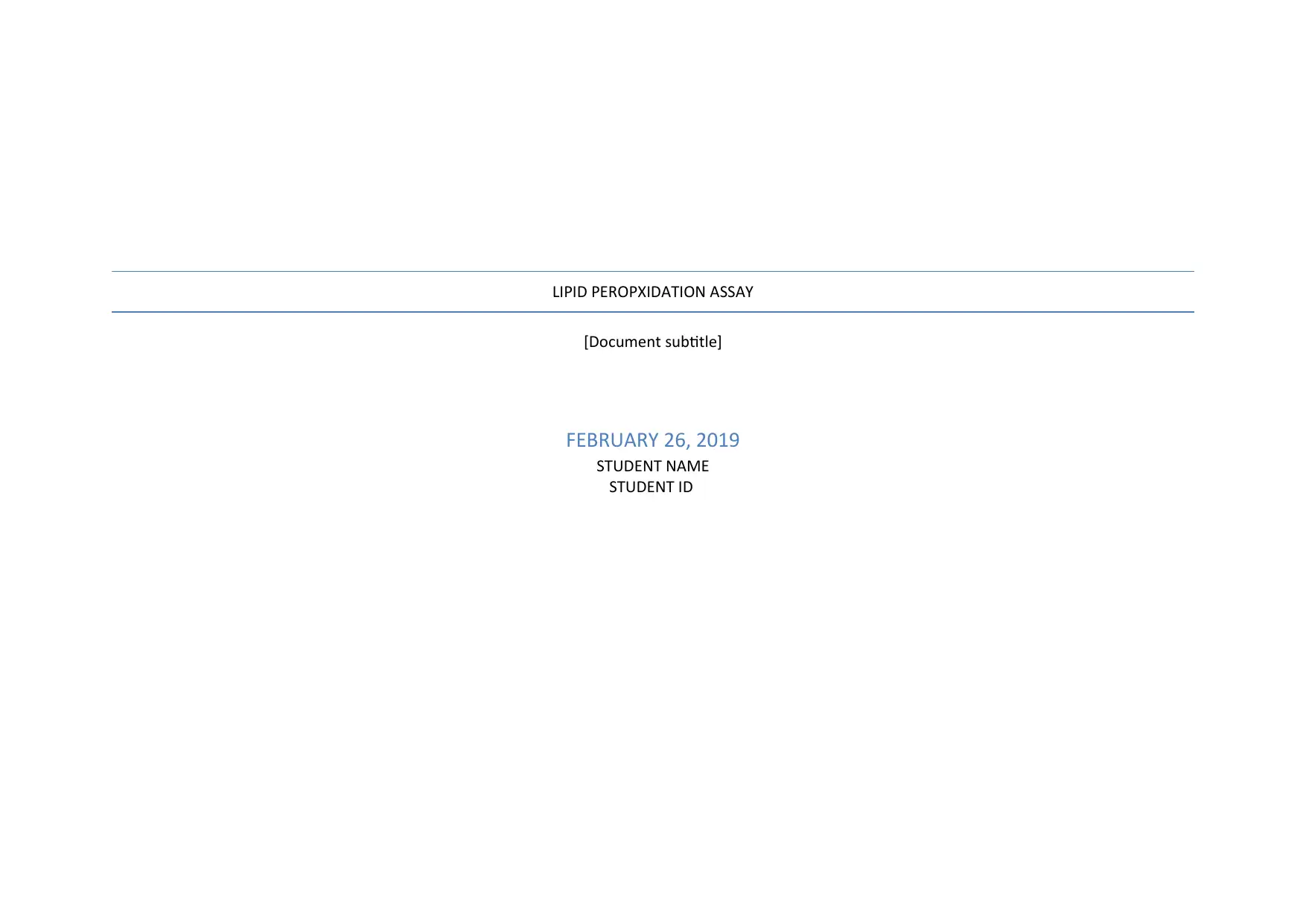
[Document subtitle]
FEBRUARY 26, 2019
STUDENT NAME
STUDENT ID
Paraphrase This Document
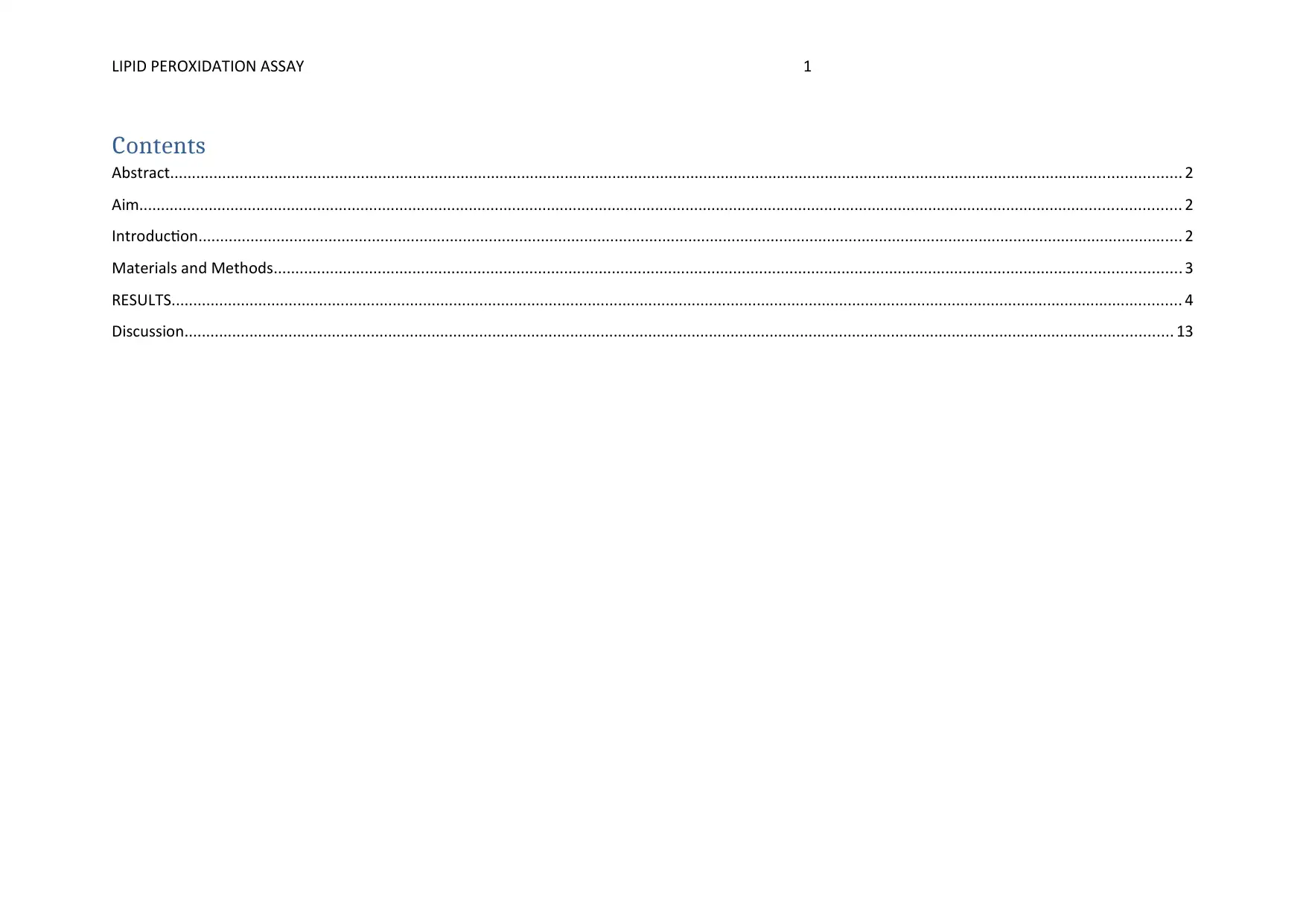
Contents
Abstract......................................................................................................................................................................................................................................... 2
Aim................................................................................................................................................................................................................................................ 2
Introduction................................................................................................................................................................................................................................... 2
Materials and Methods................................................................................................................................................................................................................. 3
RESULTS......................................................................................................................................................................................................................................... 4
Discussion.................................................................................................................................................................................................................................... 13
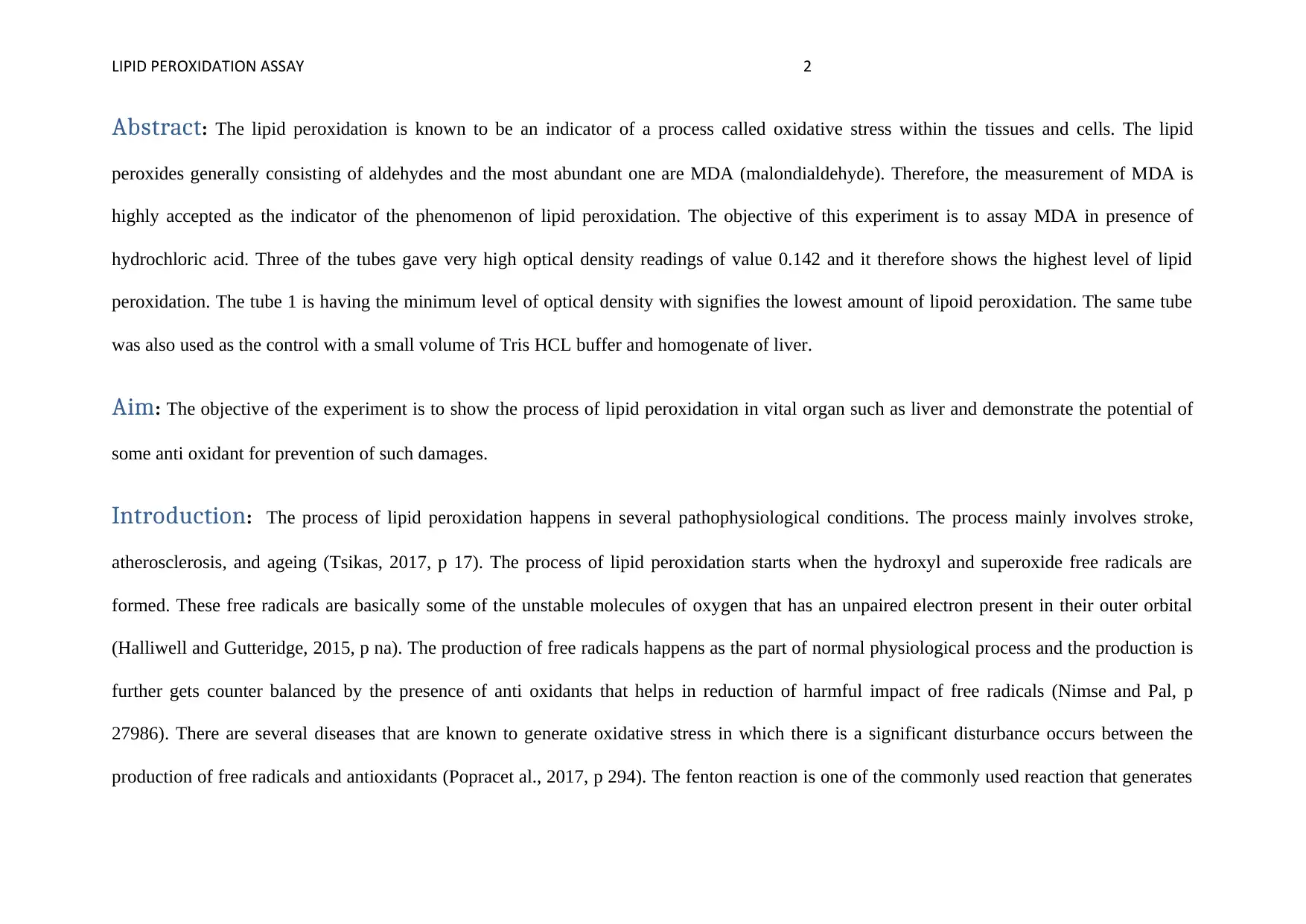
Abstract: The lipid peroxidation is known to be an indicator of a process called oxidative stress within the tissues and cells. The lipid
peroxides generally consisting of aldehydes and the most abundant one are MDA (malondialdehyde). Therefore, the measurement of MDA is
highly accepted as the indicator of the phenomenon of lipid peroxidation. The objective of this experiment is to assay MDA in presence of
hydrochloric acid. Three of the tubes gave very high optical density readings of value 0.142 and it therefore shows the highest level of lipid
peroxidation. The tube 1 is having the minimum level of optical density with signifies the lowest amount of lipoid peroxidation. The same tube
was also used as the control with a small volume of Tris HCL buffer and homogenate of liver.
Aim: The objective of the experiment is to show the process of lipid peroxidation in vital organ such as liver and demonstrate the potential of
some anti oxidant for prevention of such damages.
Introduction: The process of lipid peroxidation happens in several pathophysiological conditions. The process mainly involves stroke,
atherosclerosis, and ageing (Tsikas, 2017, p 17). The process of lipid peroxidation starts when the hydroxyl and superoxide free radicals are
formed. These free radicals are basically some of the unstable molecules of oxygen that has an unpaired electron present in their outer orbital
(Halliwell and Gutteridge, 2015, p na). The production of free radicals happens as the part of normal physiological process and the production is
further gets counter balanced by the presence of anti oxidants that helps in reduction of harmful impact of free radicals (Nimse and Pal, p
27986). There are several diseases that are known to generate oxidative stress in which there is a significant disturbance occurs between the
production of free radicals and antioxidants (Popracet al., 2017, p 294). The fenton reaction is one of the commonly used reaction that generates
⊘ This is a preview!⊘
Do you want full access?
Subscribe today to unlock all pages.

Trusted by 1+ million students worldwide
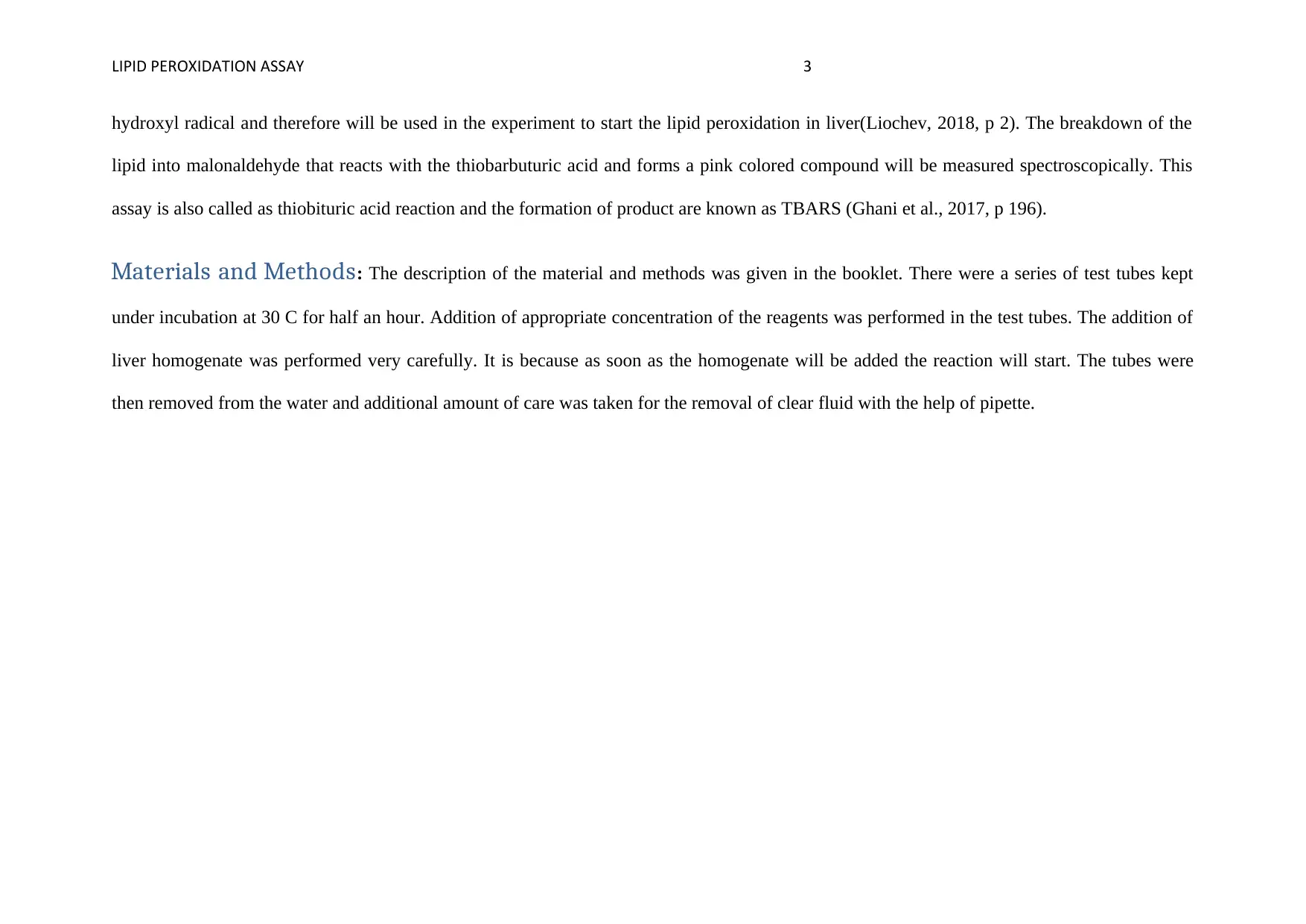
hydroxyl radical and therefore will be used in the experiment to start the lipid peroxidation in liver(Liochev, 2018, p 2). The breakdown of the
lipid into malonaldehyde that reacts with the thiobarbuturic acid and forms a pink colored compound will be measured spectroscopically. This
assay is also called as thiobituric acid reaction and the formation of product are known as TBARS (Ghani et al., 2017, p 196).
Materials and Methods: The description of the material and methods was given in the booklet. There were a series of test tubes kept
under incubation at 30 C for half an hour. Addition of appropriate concentration of the reagents was performed in the test tubes. The addition of
liver homogenate was performed very carefully. It is because as soon as the homogenate will be added the reaction will start. The tubes were
then removed from the water and additional amount of care was taken for the removal of clear fluid with the help of pipette.
Paraphrase This Document
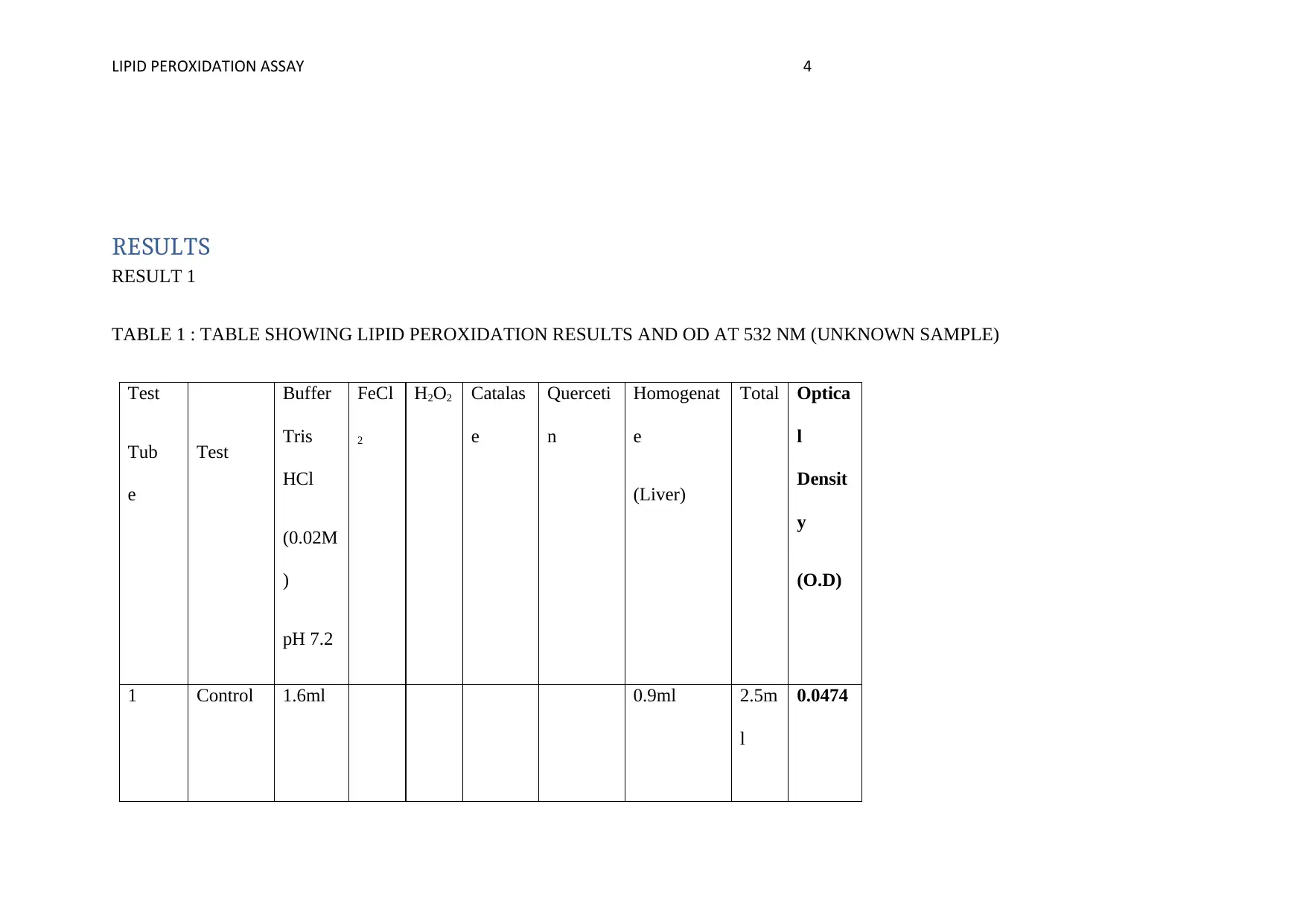
RESULTS
RESULT 1
TABLE 1 : TABLE SHOWING LIPID PEROXIDATION RESULTS AND OD AT 532 NM (UNKNOWN SAMPLE)
Test
Tub
e
Test
Buffer
Tris
HCl
(0.02M
)
pH 7.2
FeCl
2
H2O2 Catalas
e
Querceti
n
Homogenat
e
(Liver)
Total Optica
l
Densit
y
(O.D)
1 Control 1.6ml 0.9ml 2.5m
l
0.0474
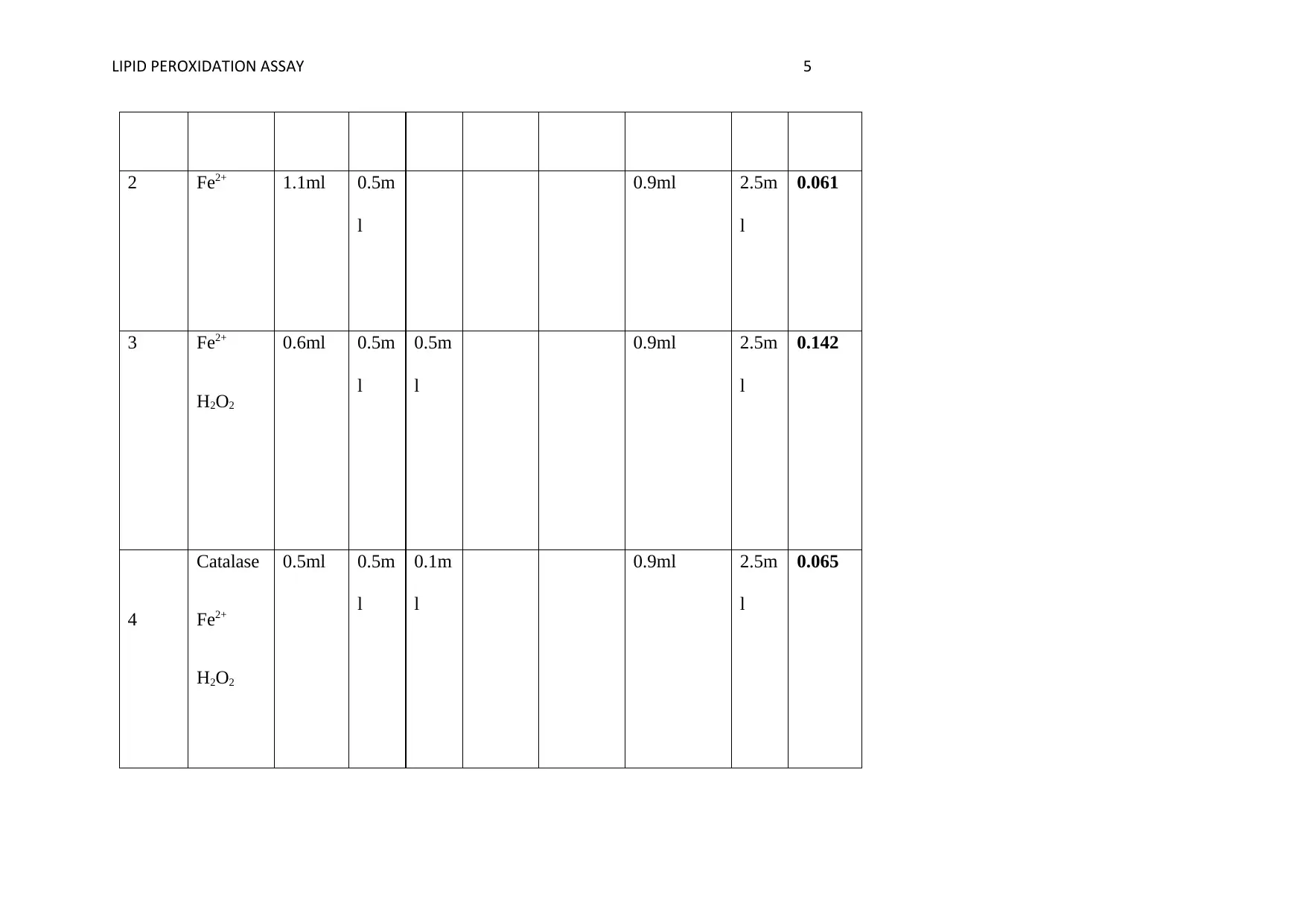
2 Fe2+ 1.1ml 0.5m
l
0.9ml 2.5m
l
0.061
3 Fe2+
H2O2
0.6ml 0.5m
l
0.5m
l
0.9ml 2.5m
l
0.142
4
Catalase
Fe2+
H2O2
0.5ml 0.5m
l
0.1m
l
0.9ml 2.5m
l
0.065
⊘ This is a preview!⊘
Do you want full access?
Subscribe today to unlock all pages.

Trusted by 1+ million students worldwide
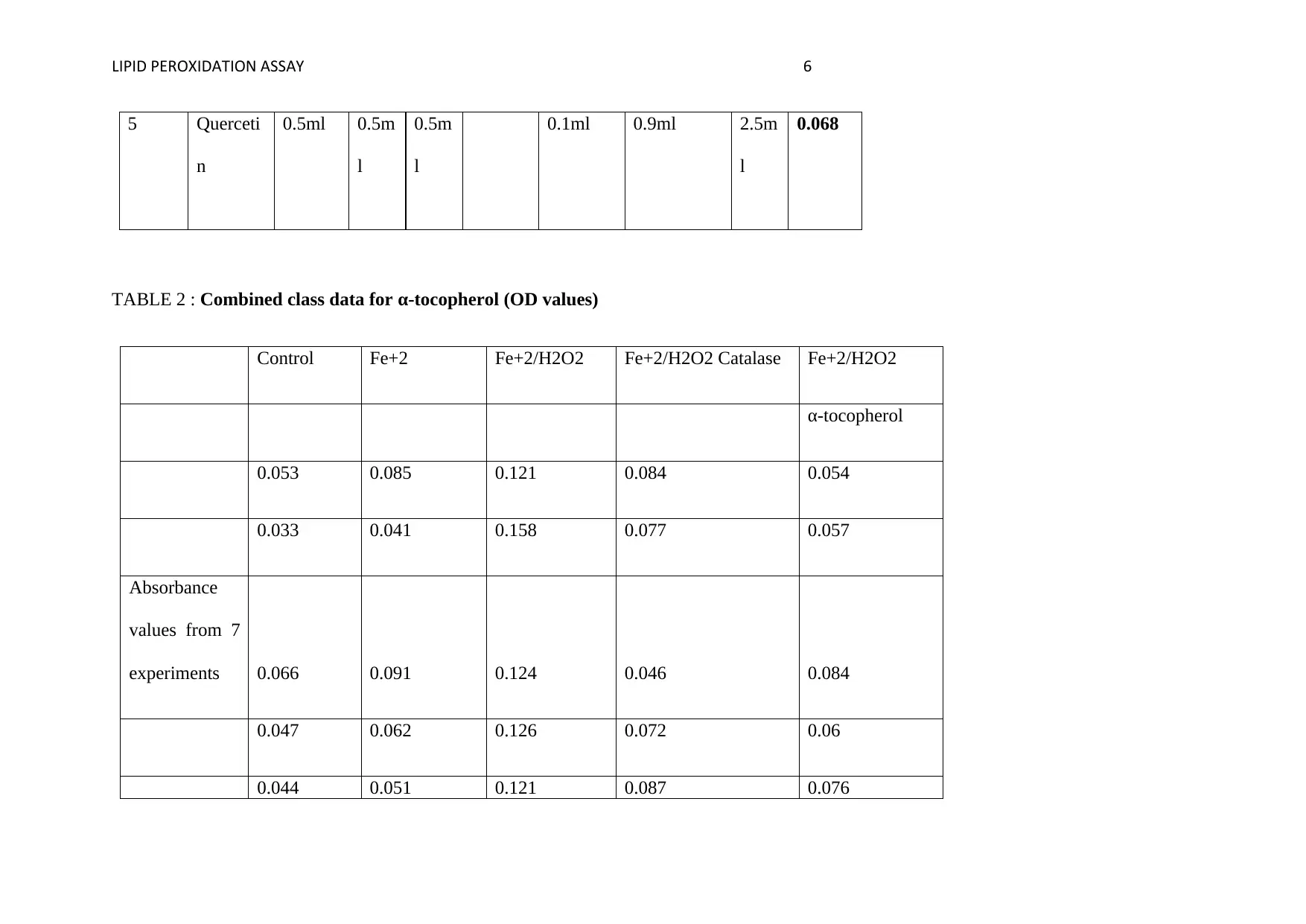
5 Querceti
n
0.5ml 0.5m
l
0.5m
l
0.1ml 0.9ml 2.5m
l
0.068
TABLE 2 : Combined class data for α-tocopherol (OD values)
Control Fe+2 Fe+2/H2O2 Fe+2/H2O2 Catalase Fe+2/H2O2
α-tocopherol
0.053 0.085 0.121 0.084 0.054
0.033 0.041 0.158 0.077 0.057
Absorbance
values from 7
experiments 0.066 0.091 0.124 0.046 0.084
0.047 0.062 0.126 0.072 0.06
0.044 0.051 0.121 0.087 0.076
Paraphrase This Document
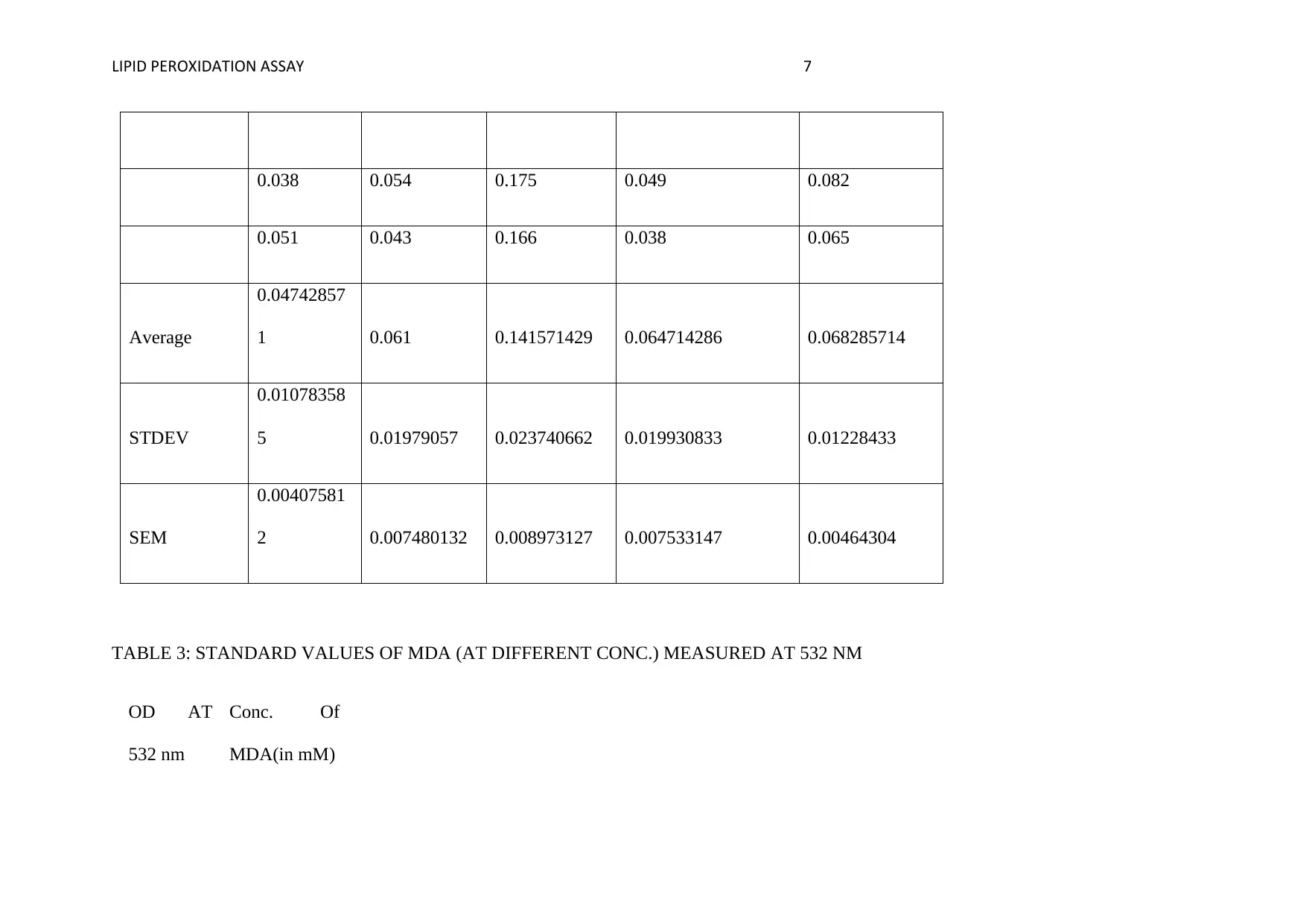
0.038 0.054 0.175 0.049 0.082
0.051 0.043 0.166 0.038 0.065
Average
0.04742857
1 0.061 0.141571429 0.064714286 0.068285714
STDEV
0.01078358
5 0.01979057 0.023740662 0.019930833 0.01228433
SEM
0.00407581
2 0.007480132 0.008973127 0.007533147 0.00464304
TABLE 3: STANDARD VALUES OF MDA (AT DIFFERENT CONC.) MEASURED AT 532 NM
OD AT
532 nm
Conc. Of
MDA(in mM)
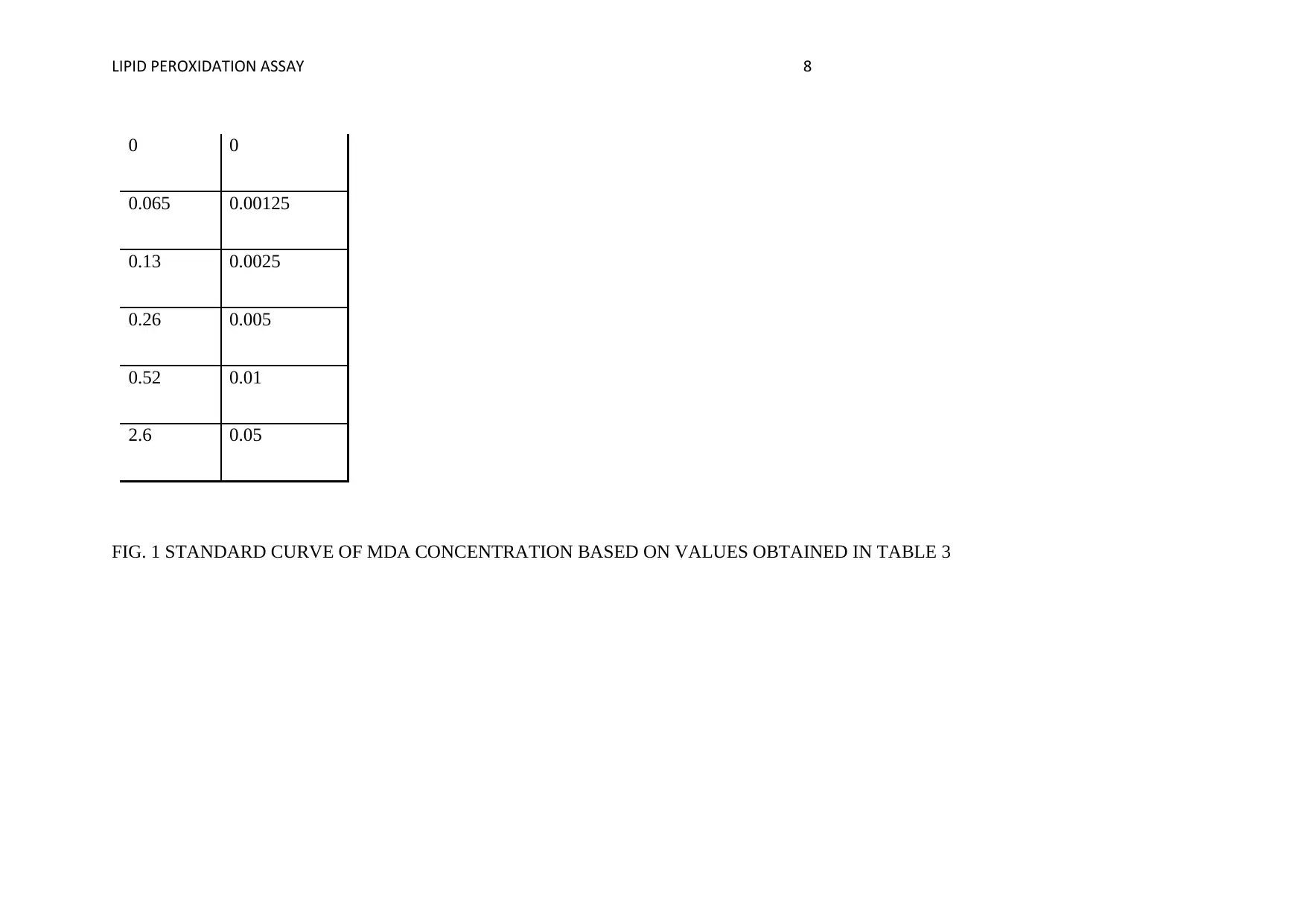
0 0
0.065 0.00125
0.13 0.0025
0.26 0.005
0.52 0.01
2.6 0.05
FIG. 1 STANDARD CURVE OF MDA CONCENTRATION BASED ON VALUES OBTAINED IN TABLE 3
⊘ This is a preview!⊘
Do you want full access?
Subscribe today to unlock all pages.

Trusted by 1+ million students worldwide
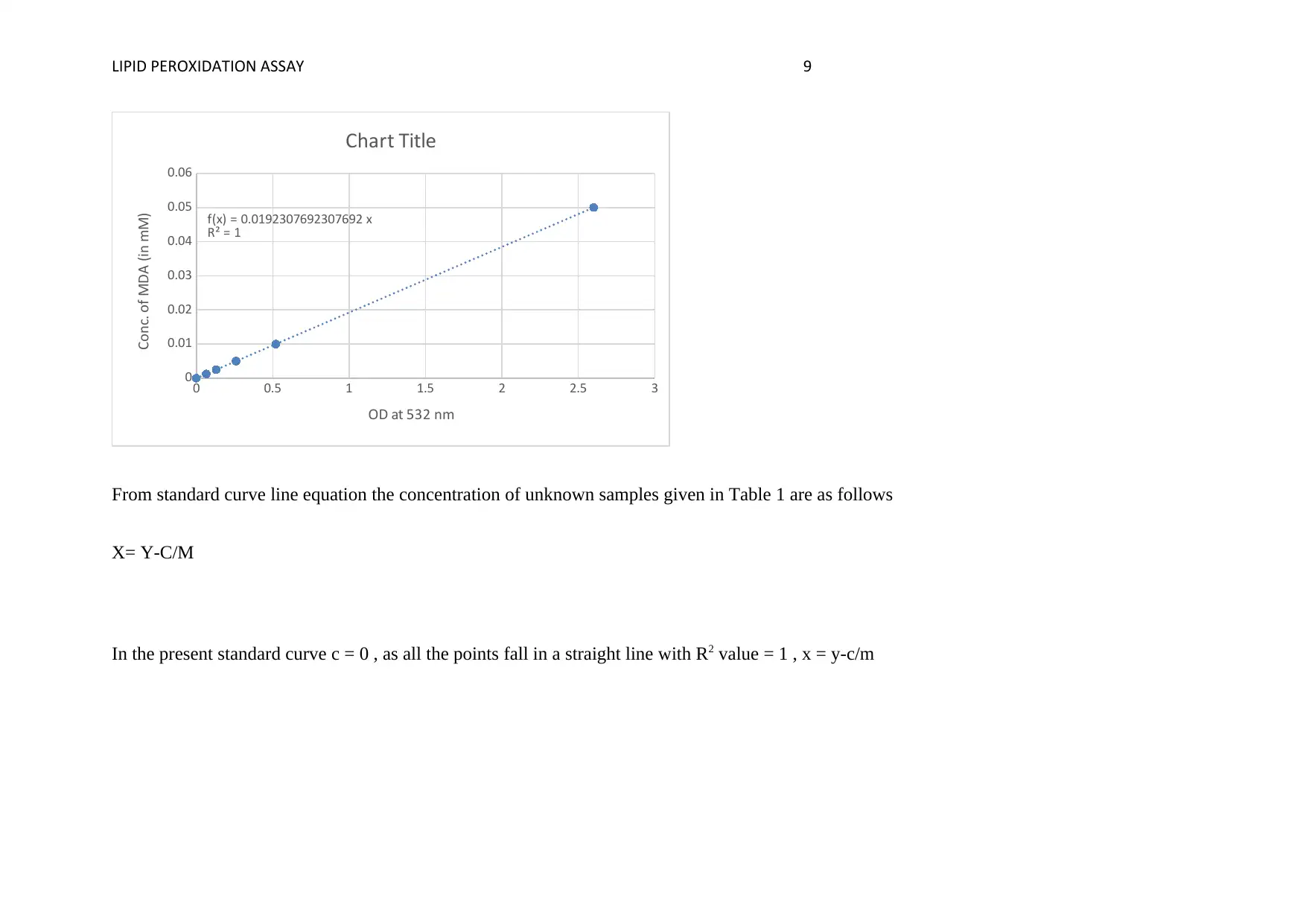
0 0.5 1 1.5 2 2.5 3
0
0.01
0.02
0.03
0.04
0.05
0.06
f(x) = 0.0192307692307692 x
R² = 1
Chart Title
OD at 532 nm
Conc. of MDA (in mM)
From standard curve line equation the concentration of unknown samples given in Table 1 are as follows
X= Y-C/M
In the present standard curve c = 0 , as all the points fall in a straight line with R2 value = 1 , x = y-c/m
Paraphrase This Document
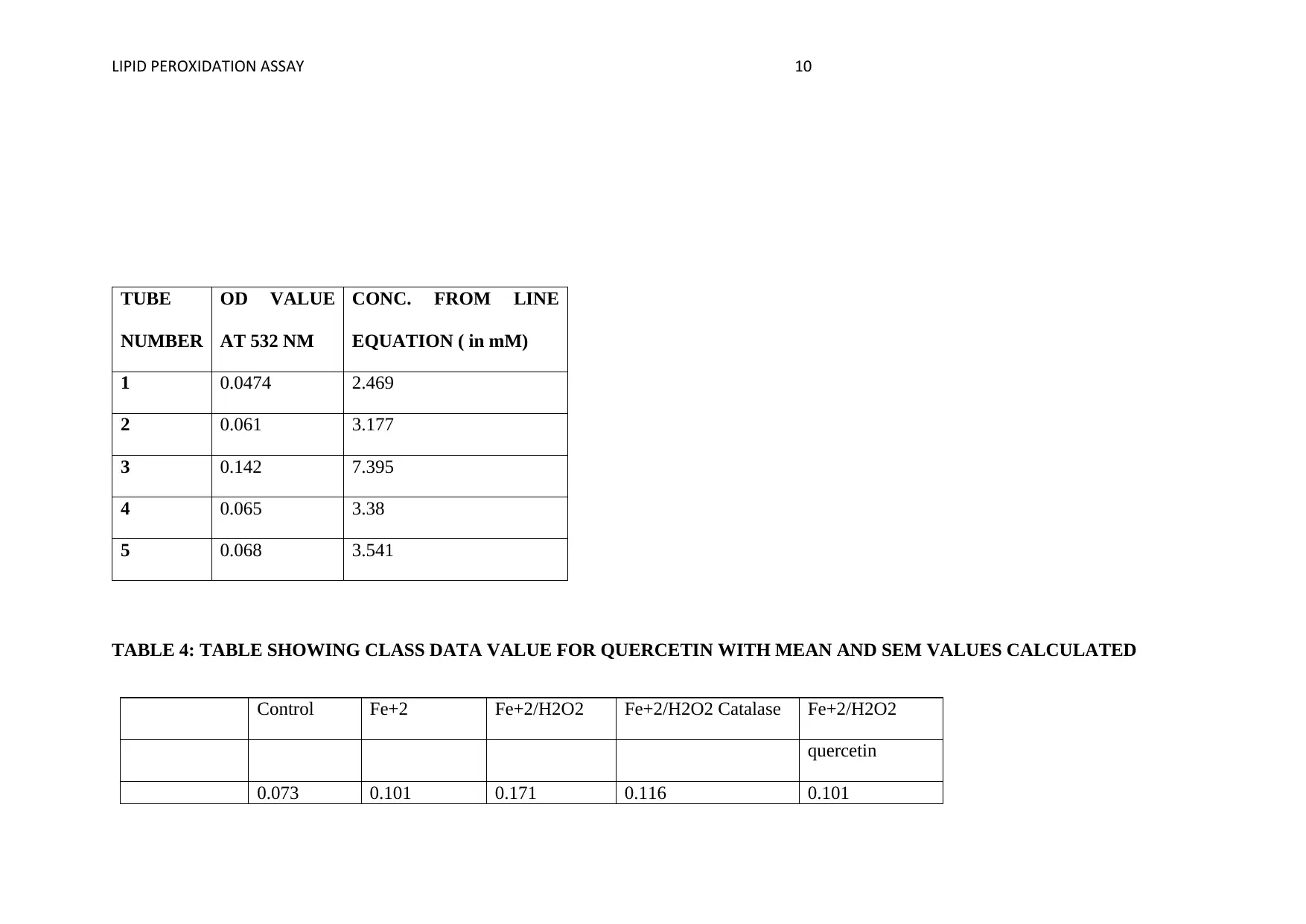
TUBE
NUMBER
OD VALUE
AT 532 NM
CONC. FROM LINE
EQUATION ( in mM)
1 0.0474 2.469
2 0.061 3.177
3 0.142 7.395
4 0.065 3.38
5 0.068 3.541
TABLE 4: TABLE SHOWING CLASS DATA VALUE FOR QUERCETIN WITH MEAN AND SEM VALUES CALCULATED
Control Fe+2 Fe+2/H2O2 Fe+2/H2O2 Catalase Fe+2/H2O2
quercetin
0.073 0.101 0.171 0.116 0.101
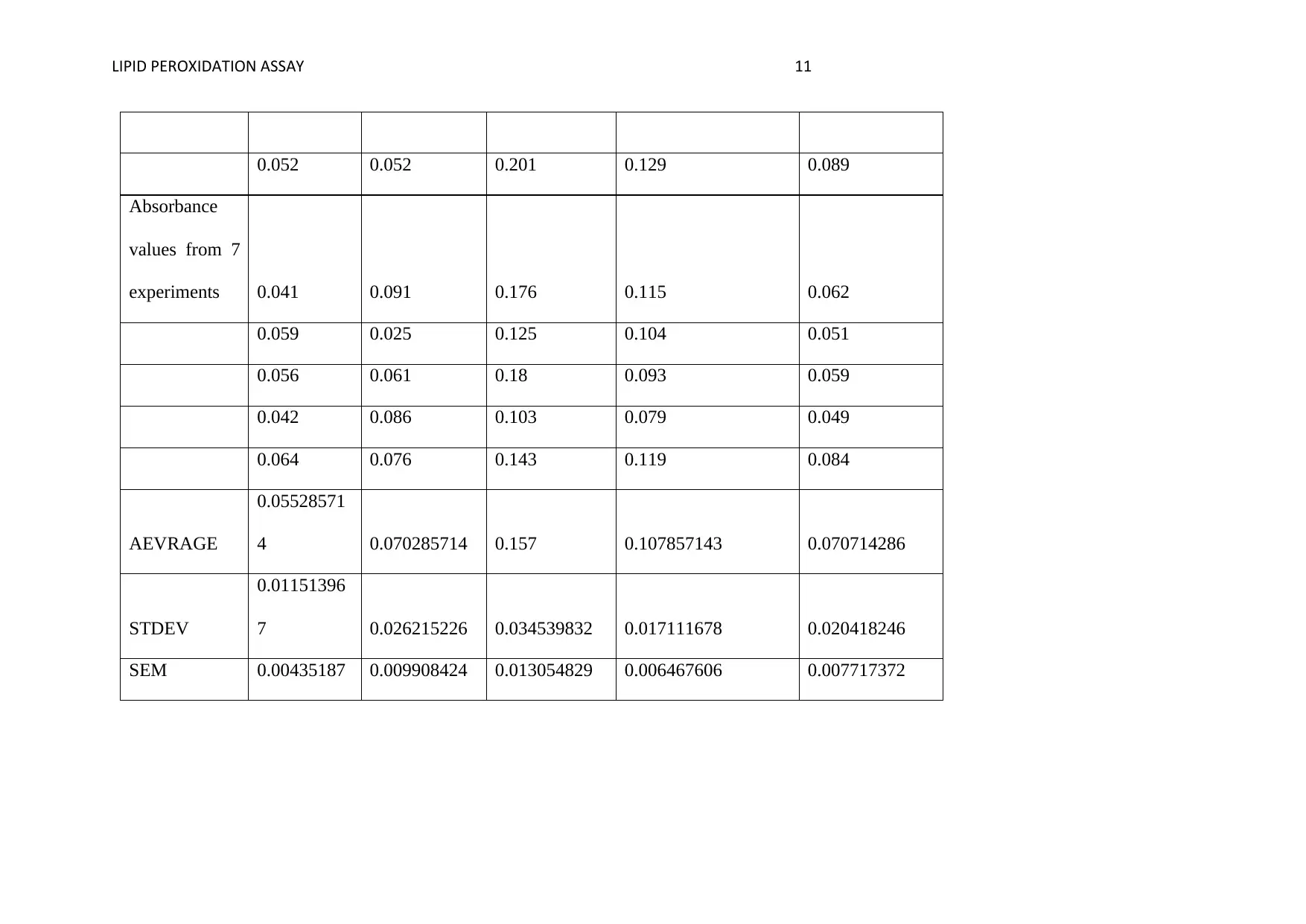
0.052 0.052 0.201 0.129 0.089
Absorbance
values from 7
experiments 0.041 0.091 0.176 0.115 0.062
0.059 0.025 0.125 0.104 0.051
0.056 0.061 0.18 0.093 0.059
0.042 0.086 0.103 0.079 0.049
0.064 0.076 0.143 0.119 0.084
AEVRAGE
0.05528571
4 0.070285714 0.157 0.107857143 0.070714286
STDEV
0.01151396
7 0.026215226 0.034539832 0.017111678 0.020418246
SEM 0.00435187 0.009908424 0.013054829 0.006467606 0.007717372
⊘ This is a preview!⊘
Do you want full access?
Subscribe today to unlock all pages.

Trusted by 1+ million students worldwide
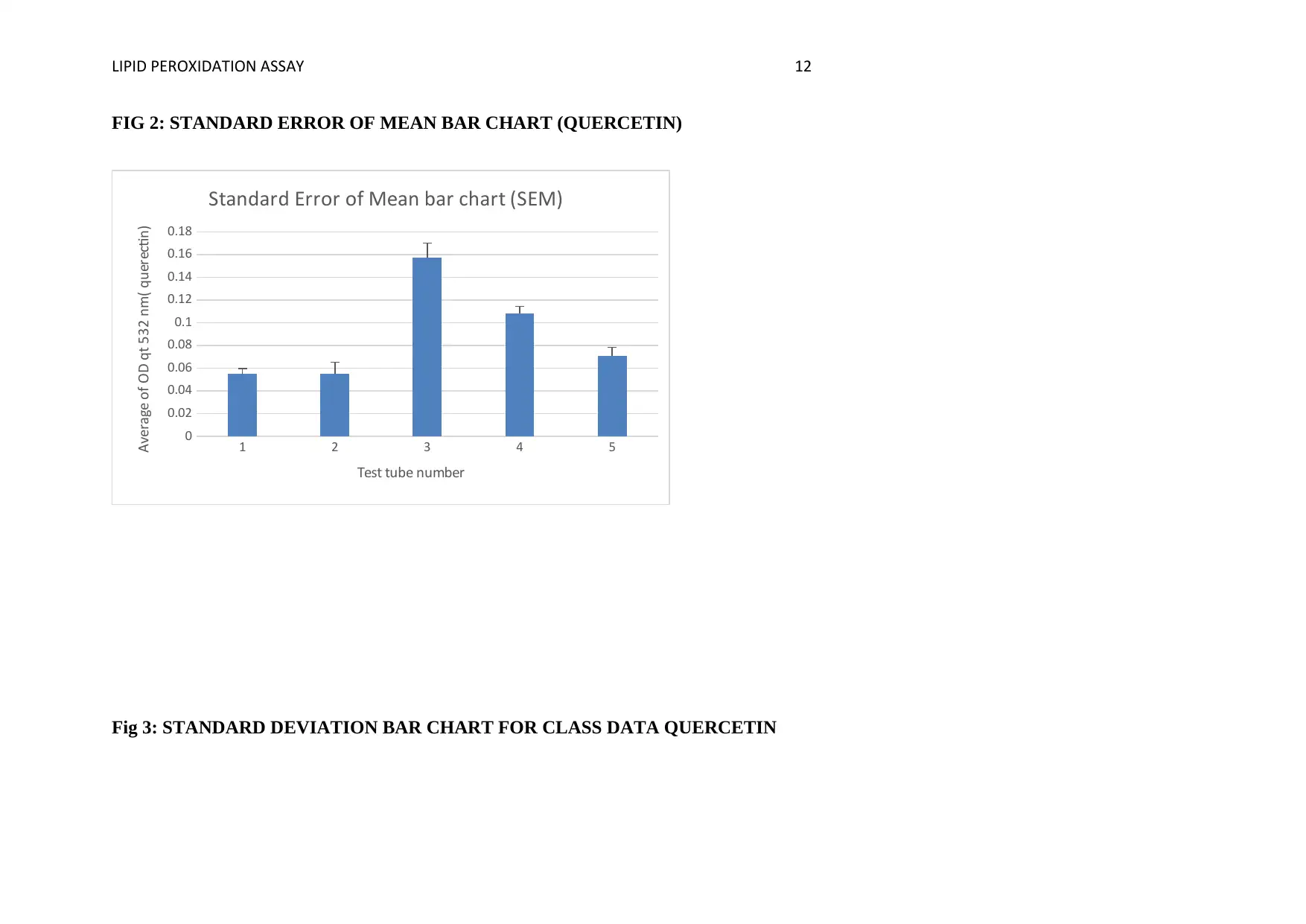
FIG 2: STANDARD ERROR OF MEAN BAR CHART (QUERCETIN)
1 2 3 4 5
0
0.02
0.04
0.06
0.08
0.1
0.12
0.14
0.16
0.18
Standard Error of Mean bar chart (SEM)
Test tube number
Average of OD qt 532 nm( querectin)
Fig 3: STANDARD DEVIATION BAR CHART FOR CLASS DATA QUERCETIN
Paraphrase This Document
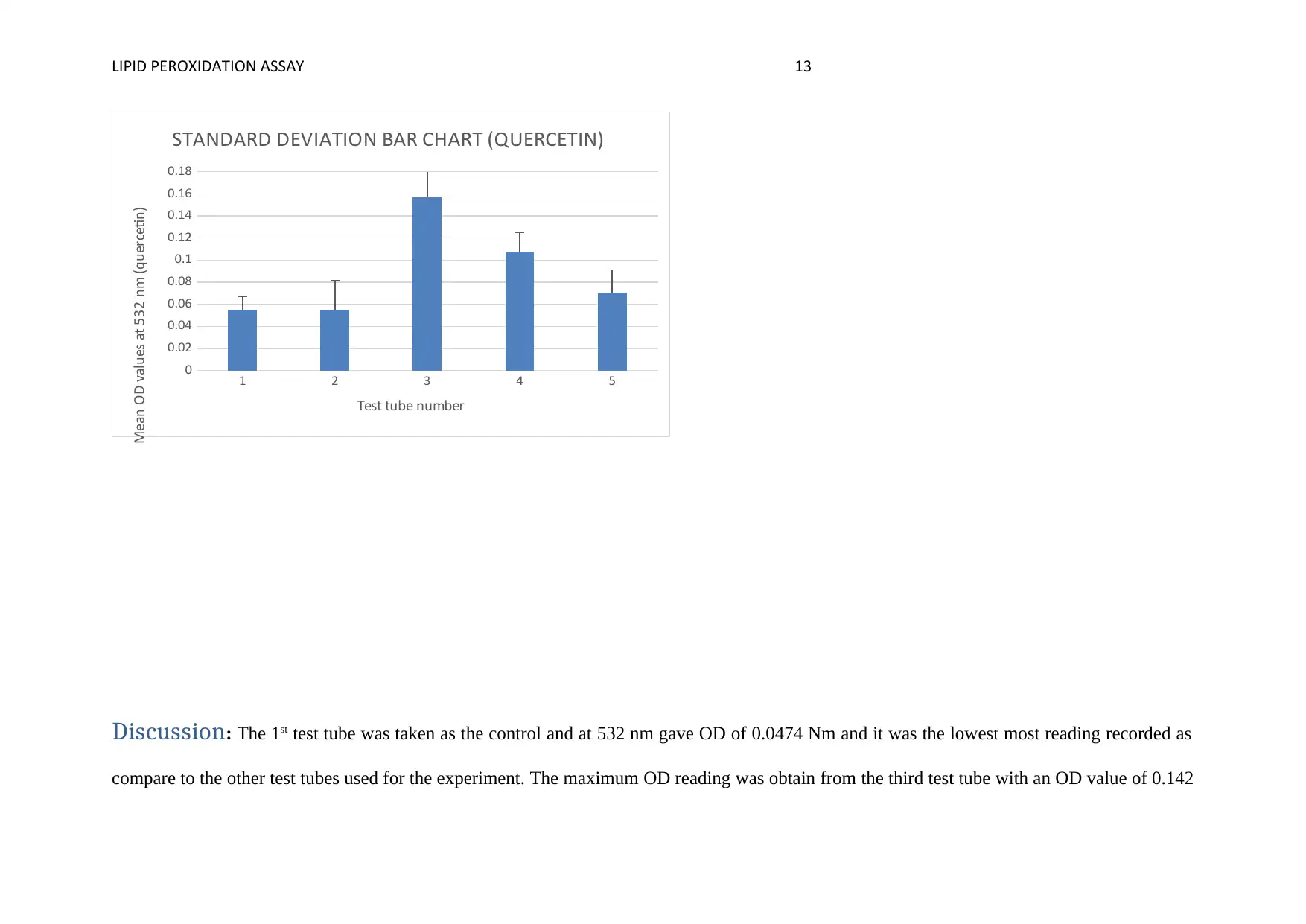
1 2 3 4 5
0
0.02
0.04
0.06
0.08
0.1
0.12
0.14
0.16
0.18
STANDARD DEVIATION BAR CHART (QUERCETIN)
Test tube number
Mean OD values at 532 nm (quercetin)
Discussion: The 1st test tube was taken as the control and at 532 nm gave OD of 0.0474 Nm and it was the lowest most reading recorded as
compare to the other test tubes used for the experiment. The maximum OD reading was obtain from the third test tube with an OD value of 0.142
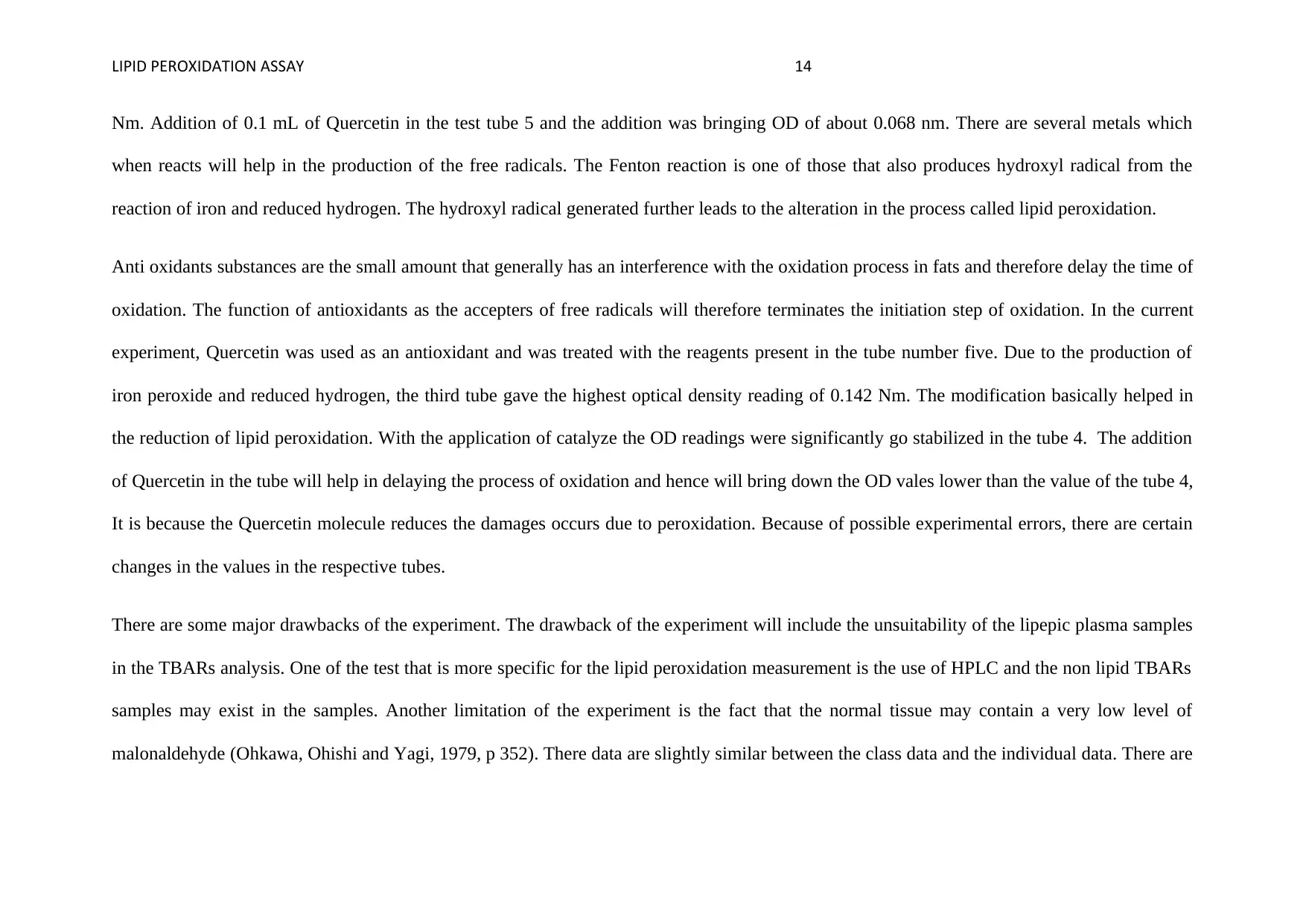
Nm. Addition of 0.1 mL of Quercetin in the test tube 5 and the addition was bringing OD of about 0.068 nm. There are several metals which
when reacts will help in the production of the free radicals. The Fenton reaction is one of those that also produces hydroxyl radical from the
reaction of iron and reduced hydrogen. The hydroxyl radical generated further leads to the alteration in the process called lipid peroxidation.
Anti oxidants substances are the small amount that generally has an interference with the oxidation process in fats and therefore delay the time of
oxidation. The function of antioxidants as the accepters of free radicals will therefore terminates the initiation step of oxidation. In the current
experiment, Quercetin was used as an antioxidant and was treated with the reagents present in the tube number five. Due to the production of
iron peroxide and reduced hydrogen, the third tube gave the highest optical density reading of 0.142 Nm. The modification basically helped in
the reduction of lipid peroxidation. With the application of catalyze the OD readings were significantly go stabilized in the tube 4. The addition
of Quercetin in the tube will help in delaying the process of oxidation and hence will bring down the OD vales lower than the value of the tube 4,
It is because the Quercetin molecule reduces the damages occurs due to peroxidation. Because of possible experimental errors, there are certain
changes in the values in the respective tubes.
There are some major drawbacks of the experiment. The drawback of the experiment will include the unsuitability of the lipepic plasma samples
in the TBARs analysis. One of the test that is more specific for the lipid peroxidation measurement is the use of HPLC and the non lipid TBARs
samples may exist in the samples. Another limitation of the experiment is the fact that the normal tissue may contain a very low level of
malonaldehyde (Ohkawa, Ohishi and Yagi, 1979, p 352). There data are slightly similar between the class data and the individual data. There are
⊘ This is a preview!⊘
Do you want full access?
Subscribe today to unlock all pages.

Trusted by 1+ million students worldwide
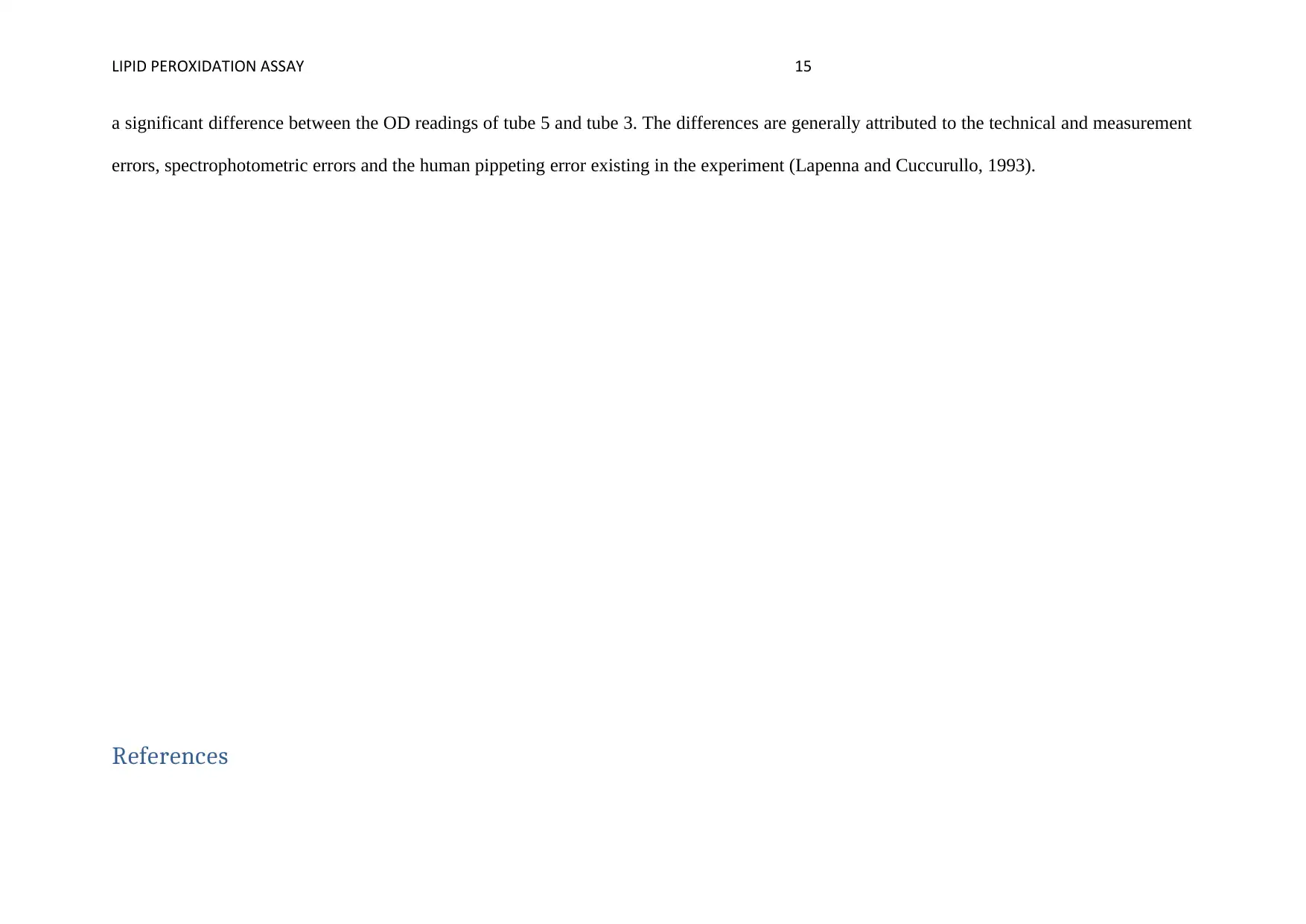
a significant difference between the OD readings of tube 5 and tube 3. The differences are generally attributed to the technical and measurement
errors, spectrophotometric errors and the human pippeting error existing in the experiment (Lapenna and Cuccurullo, 1993).
References
Paraphrase This Document
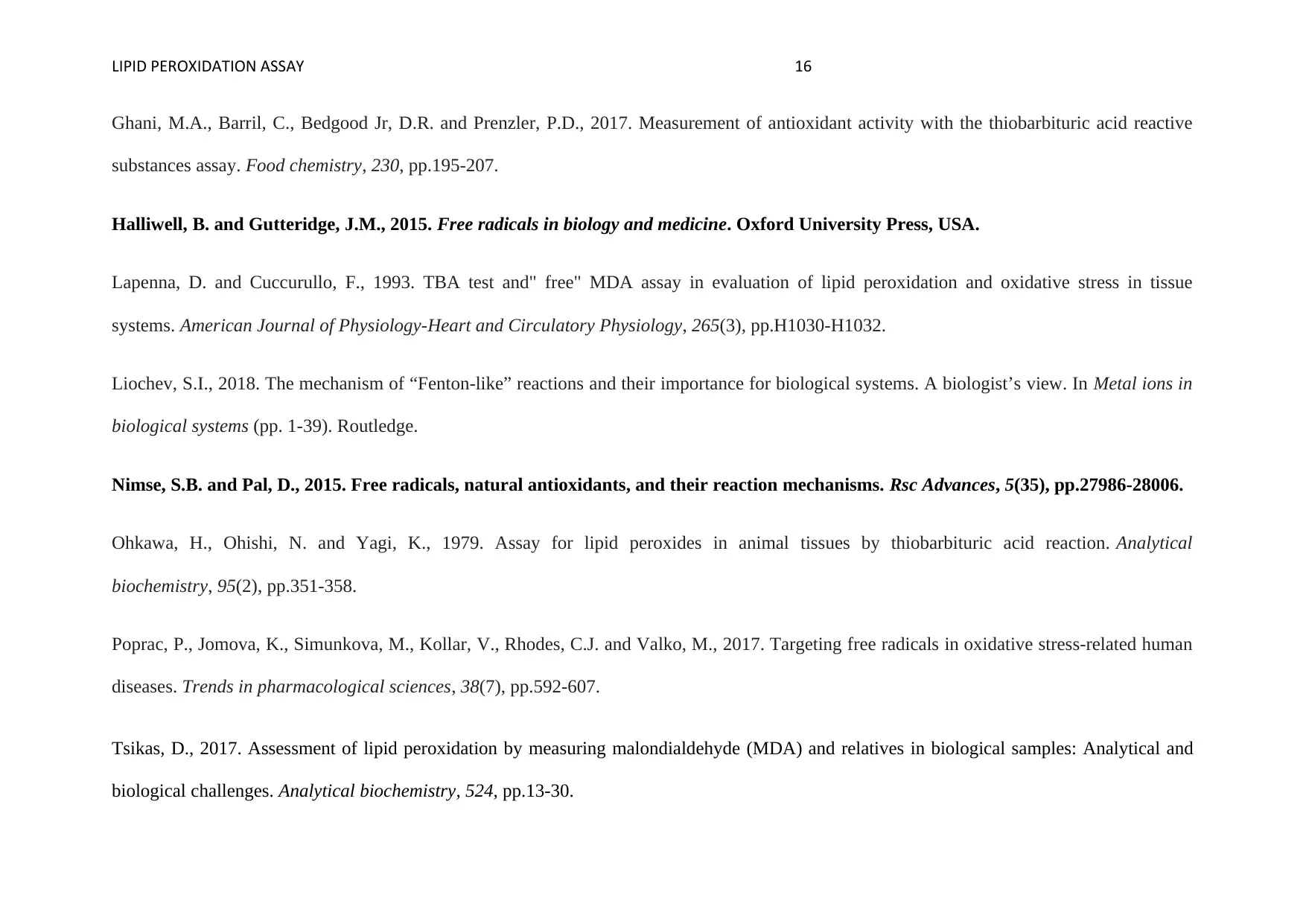
Ghani, M.A., Barril, C., Bedgood Jr, D.R. and Prenzler, P.D., 2017. Measurement of antioxidant activity with the thiobarbituric acid reactive
substances assay. Food chemistry, 230, pp.195-207.
Halliwell, B. and Gutteridge, J.M., 2015. Free radicals in biology and medicine. Oxford University Press, USA.
Lapenna, D. and Cuccurullo, F., 1993. TBA test and" free" MDA assay in evaluation of lipid peroxidation and oxidative stress in tissue
systems. American Journal of Physiology-Heart and Circulatory Physiology, 265(3), pp.H1030-H1032.
Liochev, S.I., 2018. The mechanism of “Fenton-like” reactions and their importance for biological systems. A biologist’s view. In Metal ions in
biological systems (pp. 1-39). Routledge.
Nimse, S.B. and Pal, D., 2015. Free radicals, natural antioxidants, and their reaction mechanisms. Rsc Advances, 5(35), pp.27986-28006.
Ohkawa, H., Ohishi, N. and Yagi, K., 1979. Assay for lipid peroxides in animal tissues by thiobarbituric acid reaction. Analytical
biochemistry, 95(2), pp.351-358.
Poprac, P., Jomova, K., Simunkova, M., Kollar, V., Rhodes, C.J. and Valko, M., 2017. Targeting free radicals in oxidative stress-related human
diseases. Trends in pharmacological sciences, 38(7), pp.592-607.
Tsikas, D., 2017. Assessment of lipid peroxidation by measuring malondialdehyde (MDA) and relatives in biological samples: Analytical and
biological challenges. Analytical biochemistry, 524, pp.13-30.

⊘ This is a preview!⊘
Do you want full access?
Subscribe today to unlock all pages.

Trusted by 1+ million students worldwide
Your All-in-One AI-Powered Toolkit for Academic Success.
+13062052269
info@desklib.com
Available 24*7 on WhatsApp / Email
![[object Object]](/_next/static/media/star-bottom.7253800d.svg)
© 2024 | Zucol Services PVT LTD | All rights reserved.
